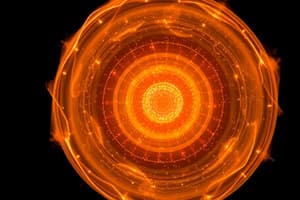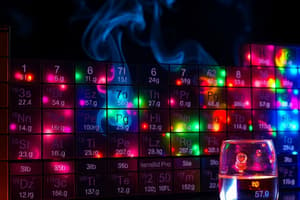Podcast
Questions and Answers
Which of the following factors contributes to the increase in ionisation energy across a period?
Which of the following factors contributes to the increase in ionisation energy across a period?
- Decreased nuclear charge
- Increased effective nuclear charge (correct)
- Addition of energy levels
- Increased atomic radius
What is the result of the shielding effect on ionisation energy?
What is the result of the shielding effect on ionisation energy?
- It increases the atomic radius
- It has no effect on the effective nuclear charge
- It increases the effective nuclear charge
- It decreases the effective nuclear charge (correct)
What is the reason for the decrease in ionisation energy down a group?
What is the reason for the decrease in ionisation energy down a group?
- Increased atomic radius (correct)
- Increased effective nuclear charge
- Removal of energy levels
- Decreased atomic radius
Why do alkali metals have lower ionisation energies than expected?
Why do alkali metals have lower ionisation energies than expected?
Why do noble gases have higher ionisation energies than expected?
Why do noble gases have higher ionisation energies than expected?
What is the main reason for the periodic trends in ionisation energy?
What is the main reason for the periodic trends in ionisation energy?
Flashcards are hidden until you start studying
Study Notes
Ionisation Energy: Periodic Trends
Ionisation energy is the energy required to remove an electron from an atom in its ground state.
Periodic Trends:
Across a Period:
- Ionisation energy increases from left to right across a period due to:
- Increased nuclear charge (more protons)
- Decreased atomic radius (electrons are closer to the nucleus)
- Increased effective nuclear charge (shielding effect decreases)
Down a Group:
- Ionisation energy decreases down a group due to:
- Increased atomic radius (electrons are farther from the nucleus)
- Decreased effective nuclear charge (shielding effect increases)
- Addition of energy levels (screening effect)
Exceptions:
- Noble gases have higher ionisation energies than expected due to their full outer energy level, making it harder to remove an electron.
- Alkali metals have lower ionisation energies than expected due to their single electron in the outermost energy level, making it easier to remove.
Key Points:
- Ionisation energy is a measure of the energy required to remove an electron from an atom.
- Periodic trends in ionisation energy are due to changes in nuclear charge, atomic radius, and effective nuclear charge.
- Understanding these trends is crucial in explaining the properties and reactivity of elements.
Ionisation Energy: Periodic Trends
Trends Across a Period
- Ionisation energy increases from left to right across a period due to increased nuclear charge and decreased atomic radius.
- Electrons are closer to the nucleus, resulting in a stronger attraction, making it harder to remove an electron.
- The shielding effect decreases, allowing the nuclear charge to have a greater influence on the outermost electron.
Trends Down a Group
- Ionisation energy decreases down a group due to increased atomic radius and decreased effective nuclear charge.
- Electrons are farther from the nucleus, resulting in a weaker attraction, making it easier to remove an electron.
- The shielding effect increases, reducing the nuclear charge's influence on the outermost electron.
- Addition of energy levels leads to a screening effect, further decreasing ionisation energy.
Exceptions
- Noble gases have higher ionisation energies than expected due to their full outer energy level.
- Alkali metals have lower ionisation energies than expected due to their single electron in the outermost energy level.
Key Points
- Ionisation energy measures the energy required to remove an electron from an atom.
- Periodic trends in ionisation energy result from changes in nuclear charge, atomic radius, and effective nuclear charge.
Studying That Suits You
Use AI to generate personalized quizzes and flashcards to suit your learning preferences.



